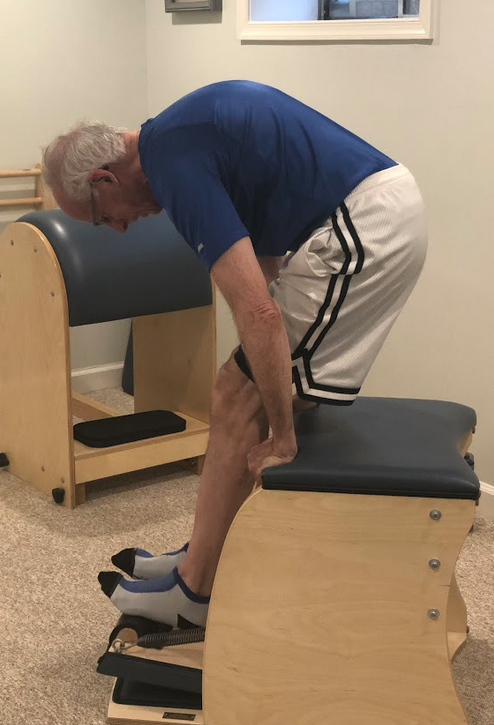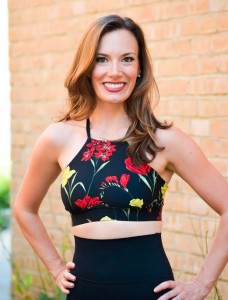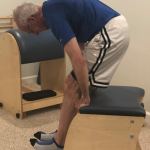June 24, 2020
Teaching Tips for Tendon Stretch that are Rooted in Motor Learning
by Chelsea Corley
Teaching Pilates is an expressive art form. That is part of the beauty in what we do as instructors. It is so fantastic that the same client can go to several different teachers and each of those teachers will see different imbalances and weaknesses as well as varied focuses within the session for the same body. This is something I believe is particularly important in our community because there is not one way that is the right way. There are a variety of ways you can approach a body; if that approach has reason behind it, I believe it to be valid.
There is always room for improvement in how we communicate what we are seeing in our clients. In our certification programs, not much time is spent on learning how to teach. We learn all of the amazing exercises, body imbalances, and exercises that are body appropriate. However, there is little discussion on how to actually teach movement and research. Motor Learning research, covering many concepts that will enhance the learning of a motor skill, isn’t incorporated into most training programs.
One technique that our certification programs touch on is demonstration of exercises. However, the use of demonstration is not necessarily beneficial to learning a motor skill (discussed in my previous Pilates Intel article) – when a beginner watches us demonstrate, their visual cortex is active rather than their motor cortex. Meaning that the demonstration is not helping them learn the motor skill by watching. Without using demonstration, how should one begin to teach an individual a new movement?
The first thing that we need to realize is just because the client follows our cues and produces the action, that doesn’t mean they learned the skill. I guarantee if you asked the client today to produce the exercise they first learned last week, you will receive a blank stare. This means that we need to recognize that learning is a process and will occur over time. It could take someone three weeks or even three months to create that neural change in their brain.
To help the process of neural change, this is how I begin teaching a client a new exercise. Let’s use the Tendon Stretch on the Wunda Chair as an example. There are two things we must assume: first, the client is not a beginner; second, they are already successful at doing the Pull Up on the Wunda chair. This means the client has the ability to use their lower abdominals to pull the pedal up but the change of orientation of their body needed for Tendon Stretch will require them to use these muscles differently. Therefore, the skills are similar but not the same.
The first time I teach the client the Tendon Stretch, I will set them into position by saying “Sit on the chair with your feet on the pedal in a parallel position. Your hands will be on the front edge of the chair. Press the pedal to the floor and straighten your legs as much as you can with your arms straight and hands pressing into the chair. This is your starting position.” It is especially important for their learning to know what their starting position is so they can create the reference in their mind and body.
Next, I will focus on the movement. “With your hips staying forward from the chair edge, push your hands into the chair and lift the pedal up keeping your legs as straight as you can.” Now, this might not seem like a great cue, but it is a direction. It gives the client something simple to focus on. Their hips should stay forward; their arms and legs should remain as straight as possible. This cueing focuses on the alignment of the body promoting the bones to be stacked correctly to execute the exercise. If the bones are not aligned, the proper muscles will never be able to activate.

I will then ask the client to perform the exercise as I watch. I only give them corrections based on the prompt. If their head is popping up or their feet are coming apart, I am going to ignore this for now. I want them to focus on the body alignment first and understand where their body needs to be in space. If the body is not in alignment, then a muscular bypass can occur. A muscular bypass is when the muscle group we are trying to activate gets “bypassed” or skipped over because the more trained muscles will kick in to produce the action. In the Tendon Stretch, if the hips are not in the correct alignment, the activation of the lower abdominals will be skipped and the back extensors and the shoulders will be used instead to produce the movement. This is why the alignment is key to achieve first, because when the alignment is correct, we can begin to focus on the proper muscles initiating and producing the movement.
I will focus on alignment for as many sessions as it may take for them to be able to reproduce the shape. The brain and body both need this repetition in learning a skill. The body needs to be able to experience both misalignment and proper alignment to learn what “feels” right. Without this, no error detection process will occur and clients will not learn how to self-correct.

As they become more proficient in Tendon Stretch, we can layer oppositional cues and dynamics to make the work more challenging. We can also change their environment by lightening the springs. My goal for the client is to eventually have them be able to produce this exercise without me giving them any prompts and only limited cues. That is how I know the exercise has been truly learned and that neural change has occurred.
There is a lot of research in the Motor Learning field that discusses how to construct and deliver cues and corrections to enhance the learning of a skill. The more clear and specific the cue is to the body in front of you the better. Generic cues such as “scoop” or “C-curve” does not tell the participant what they need to do with their body. Their brain isn’t able to process what their body should do when they hear the word “scoop”. Telling someone HOW to scoop is way more effective and is how corrections should be given.
The first concept I encourage you to play around with when teaching a new skill is to focus your cues on alignment. Only correct that for a while and see what happens. Begin to reduce your corrections and see if clients can reproduce the skills you are asking them to do. Then start to layer the muscle initiations and oppositional forces. I think you will be pleasantly surprised with the results you see from your clients and how much easier it is on you as well. Learning is a process; these steps help make that process clearer and achievable.
 Chelsea Corley is a Romana’s Pilates Certified Pilates Instructor who found Pilates as a young dancer and decided to become certified when she sustained a hip injury. Chelsea has been teaching since 2010 and has taught at studios in NYC as well as in the D.C. area. While Chelsea was still living in NYC, she received her master’s degree in Biobehavioral Science and Motor Learning and Control at Teachers College, Columbia University. Studying these Motor Learning concepts, she was able to apply this to her teaching of Pilates. Chelsea learned the real craft of teaching and realized that teaching is a skill, just like learning Pilates. She refined her skills using the concepts she learned in her Motor Learning Theory degree from Columbia. She has used this methodology of teaching to help coach her staff when she managed a Pilates Department for a high-end luxury fitness club as well as when she opened her own Pilates studio. Chelsea now is the owner of Integrated Pilates Studio, LLC in Falls Church, VA. She is also the creator of Integrated Teaching System which is an online educational platform for Pilates teachers that has various workshops based in Motor Learning theories and concepts that benefit Pilates instructors and their teaching. Her mission is to help Pilates instructors be able to refine their craft of teaching, and help their clients see results by using the methodologies that she learned and has refined over the years of studying the research in the field of Motor Learning and Control.
Chelsea Corley is a Romana’s Pilates Certified Pilates Instructor who found Pilates as a young dancer and decided to become certified when she sustained a hip injury. Chelsea has been teaching since 2010 and has taught at studios in NYC as well as in the D.C. area. While Chelsea was still living in NYC, she received her master’s degree in Biobehavioral Science and Motor Learning and Control at Teachers College, Columbia University. Studying these Motor Learning concepts, she was able to apply this to her teaching of Pilates. Chelsea learned the real craft of teaching and realized that teaching is a skill, just like learning Pilates. She refined her skills using the concepts she learned in her Motor Learning Theory degree from Columbia. She has used this methodology of teaching to help coach her staff when she managed a Pilates Department for a high-end luxury fitness club as well as when she opened her own Pilates studio. Chelsea now is the owner of Integrated Pilates Studio, LLC in Falls Church, VA. She is also the creator of Integrated Teaching System which is an online educational platform for Pilates teachers that has various workshops based in Motor Learning theories and concepts that benefit Pilates instructors and their teaching. Her mission is to help Pilates instructors be able to refine their craft of teaching, and help their clients see results by using the methodologies that she learned and has refined over the years of studying the research in the field of Motor Learning and Control.

